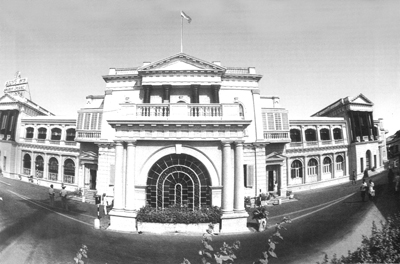
The home of the Legislative Assembly and Secretariat in Fort. St. George in the early 2000s.
|

Fort Council Chamber (right, centre) in the 1785 when the first Legislative met in 1861.
|
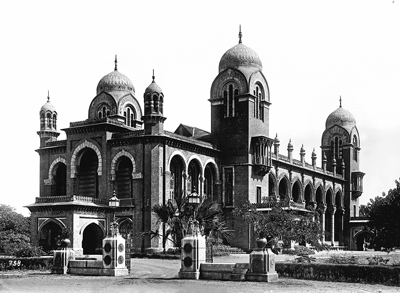
Senate House, where the Assembly met in 1937-38.
|
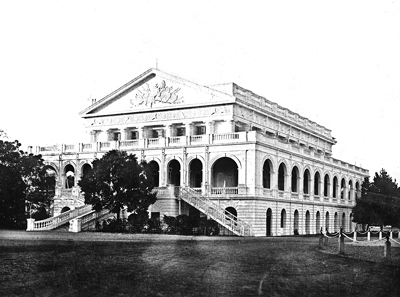
Banqueting Hall, where the Assembly met in 1938-39.
|
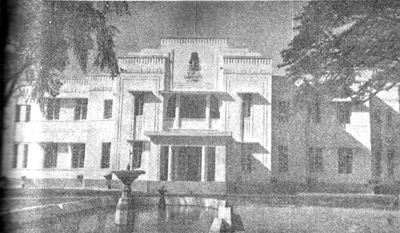
Home of the Legislature in 1952, later
Kalaivanar Arangam.
|
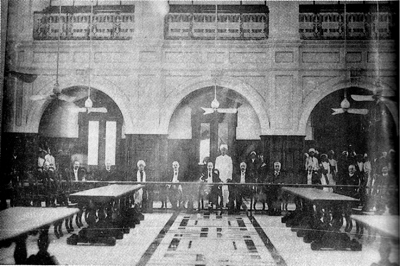
The Assembly Hall in Fort St. George in 1911.
|
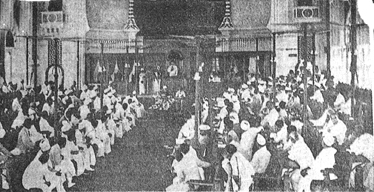
The Assembly Hall in Senate House in 1937.
|
The Speakers
1. J. Shivashanmugam Pillai
2. N. Gopala Menon
3. U. Krishna Rao
4. S. Chellapandian
5. Si.Pa. Adithanar
6. Pulavar K. Govindan
7. K.A. Mathiazhagan
8. P. Seenivasan (Acting Speaker)
9. Munu Adhi
10. K. Rajaram
11. P.H. Pandian
12. M. Tamilkudimagan
13. R. Muthiah
14. P.T.R. Palanivel Rajan
15. K. Kalimuthu
16. R. Avudaiappan
17. D. Jayakumar
18. P. Dhanapal
|
The Prime & the
Chief Ministers
1. P.S. Kumaraswamy Raja
2. C. Rajagopalachari
3. K. Kamaraj
4. M. Bhakthavatsalam
5. C.N. Annadurai
6. V.R. Nedunchezhiyan (Acting)
7. M. Karunanidhi
8. M.G. Ramachandran
9. Janaki Ramachandran
10. J. Jayalalithaa
11. O. Panneerselvam
|
The first Legislature of any
kind to be established in
Madras was the Madras Legislative
Council in 1861. First established
as a non-representative
advisory body, it saw the introduction
of elected members in
1892. The Indian Councils Act,
1909 (under the popularly called
'Minto-Morley Reforms') officially
introduced indirect election
of members to the Council.
In 1919, direct elections were introduced
with introduction of
Diarchy under the Government
of India Act of 1919. Between
1920 and 1937, the Legislative
Council was an unicameral legislature
for the Madras Presidency.
The Government of India Act of
1935 abolished diarchy and created
a bicameral legislature in
Madras Province. The Legislature
consisted of the Governor
and two Legislative bodies – a
Legislative Assembly and a Legislative
Council. The Assembly
was the lower house and consisted
of 215 members, who were
further classified into general
members and reserved members
representing special communities
and interests.
The presiding officer of the
Assembly was called the Speaker
of the Assembly.
The first Assembly of the Madras
Presidency met in the Senate
House of Madras University
in 1937.
The first Legislative Assembly
election for the Presidency was
held in February 1937. The Indian
National Congress obtained
a majority by winning 159 of 215
seats. C Rajagopalachari became
the first elected Chief Minister of
the Presidency (called the Prime
Minister or Premier until 1952)
under the provincial autonomy
system guaranteed by the Government
of India Act of 1935.
The first Assembly was constituted
in July 1937. Bulusu
Sambamurthi and A. Rukmani
Lakshmipathi were elected as the
Speaker and Deputy Speaker respectively.
The first Assembly
lasted its term, till February
1943, but the Congress Cabinet
resigned in October 1939, protesting
against India's participation
in World War II. During
1939-46, Madras was under the
direct rule of the Governor and
no elections were held in 1943
when the Assembly's term expired.
The next elections were
held only in 1946, when a political
compromise was reached between
the Congress and the
Viceroy, Lord Wavell. The second
Assembly of the Presidency
was thus constituted in April
1946. The Congress won an absolute
majority in the elections
and again formed the Government.
On August 15, 1947, India
became independent and the
new Indian Constitution came
into effect on January 26, 1950.
Madras Presidency became Madras
State and the then-existing
Assembly and the Government
were retained till new elections
could be held in 1952.
In the Republic of India, the
Madras State Legislative Assembly
continued to be the lower
house in a bicameral legislature.
The first election to the Assembly
on the basis of universal adult
suffrage was held in January
1952. According to the Delimitation
of Parliamentary and Assembly
Constituencies (Madras)
Order, 1951, promulgated by
President under Sections 6 and 9
of the Representation of People
Act, 1950, the Assembly's
strength was 375 members
elected from 309 constituencies.
Out of the 309 constituencies in
the undivided Madras State, 66
were two-member constituencies,
62 of which had one seat
reserved for Scheduled Caste
candidates and four for Scheduled
Tribe candidates. The two-member
constituencies were established
in accordance with Article
332 of the Indian Constitution.
The voting method and the
plurality of electoral formula
were defined in the Representation
of People Act, 1950. These
constituencies were large in size
and had greater number of voters
(more than 100,000) than
general constituencies. Multiple
members were elected only in the
1952 and 1957 elections as
double member representation
was abolished in 1961 by the enactment
of Two-Member Constituencies
Abolition Act
(1961). Of the 375 seats, 143
were from what later became
Andhra State, 29 from Malabar,
11 from South Canara (part of
present-day Karnataka) and the
remaining 190 belonged to the
present-day Tamil Nadu.
On October 1, 1953, a separate
Andhra State, consisting of
the Telugu-speaking areas of the
composite Madras State, was
formed and the Kannada-speaking
area of Bellary District was
merged with the then Mysore
State. This reduced the strength
of the Legislative Assembly to
231. On November 1, 1956, the
States Reorganisation Act took
effect and consequently the constituencies
in the erstwhile
Malabar District were merged
with the Kerala State. This further
reduced the strength to 190.
The Tamil-speaking area of
Kerala (present-day Kanniyakumari
District) and Shenkottah
taluk were added to Madras
State. According to the new Delimitation
of Parliamentary and
Assembly Constituencies Order
of 1956, made by the Delimitation
Commission of India under
provisions of the States
Reorganisation Act of 1956, the
strength of the Assembly was increased
to 205. The 1957 elections
were conducted for these
205 seats. In 1959, as a result of
the Andhra Pradesh and Madras
(Alteration of Boundaries) Act
1959, one constituency from the
Andhra Pradesh Legislative Assembly
was allotted to Madras,
increasing its Legislative Assembly
strength to 206. The 1962
elections were conducted for
these 206 seats.
In 1965, the elected strength
of the Assembly was increased to
234 under the Delimitation of
Parliamentary and Assembly
Constituencies Order, 1965. In
addition to 234, the Assembly
also has one nominated member
representing the Anglo-Indian
community. From 1965, the
number of members has remained
constant.
In 1969, Madras State was renamed
Tamil Nadu and subsequently
the Assembly came to be
known as the Tamil Nadu Legislative
Assembly. The Legislative
Council was abolished with effect
from November 1, 1986
through an Act of Parliament
titled the 'Tamil Nadu Legislative
Council (Abolition) Act,
1986.' With the abolition of the
Council, the legislature became
an unicameral body and remained
so for the next 24 years.
Of the 14 Assemblies that have
been constituted so far, four (the
sixth, seventh, ninth and tenth)
have been dismissed by the Central
Government using Article
356 of the Indian Constitution.
The Legislative Assembly is
seated in Fort St. George. Fort
St. George has historically been
the seat of power of the Government
of Tamil Nadu from the
founding of the city as
Madraspatnam in 1640. During
1921-37, the precursor to the
Assembly, the Madras Legislative
Council, met in the Council
Chambers within the Fort. Between
July 14, 1937 and December
21, 1938, the Assembly met
in the Senate House of the University
of Madras and between
January 27, 1938 and October
26, 1939 in the Banqueting Hall
(later renamed Rajaji Hall) in
the Government Estate. During
1946-52, it moved back to Fort
St. George.
In 1952, the strength of the
Assembly rose to 375, after the
constitution of the First Assembly,
and it was briefly moved into
temporary premises in the Government Estate Complex. This
move was made in March 1952,
as the existing Assembly building
only had a seating capacity of
260. Then, on May 3, 1952, it
moved into a newly constructed
Assembly building in the same
Estate. The Assembly functioned
from the new building (later renamed
'Kalaivanar Arangam')
during 1952-56. However, with
the reorganisation of States and
formation of Andhra, the
strength came down to 190 and
the Assembly moved back to
Fort St. George. From December
1956 till January 2010, the Fort
remained the home to the Assembly.
In 2004, during the 12th Assembly,
the AIADMK Government
made unsuccessful attempts
to shift the Assembly,
first to a site in Queen Mary's
College and later in the Anna
University campus, Guindy.
Both attempts were withdrawn
after public opposition. During
the 13th Assembly, the DMK
Government proposed a new
plan to shift the Assembly and
the Secretariat to a new building
in Government Estate. Construction
began in 2008 and was
completed in 2010. The new Assembly
building was opened and
the Assembly started functioning
in it from March 2010. After the
AIADMK's victory in the 2011
elections, the Assembly shifted
back to Fort St. George. – (Courtesy:
TCC Digest.)
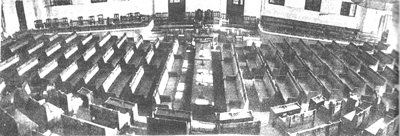
The Assembly Hall in Government Estate in 1952.
|
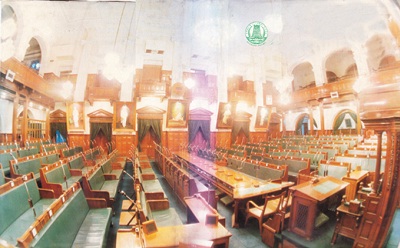
The Assembly Hall in Fort St. George in the early 2000s.
|
|